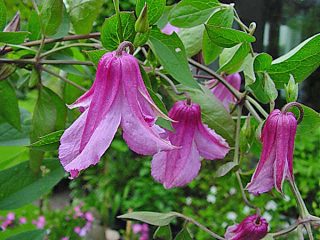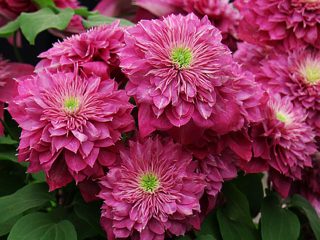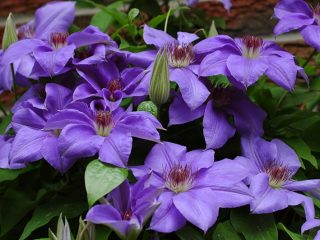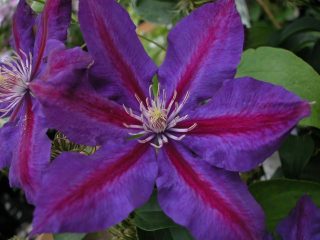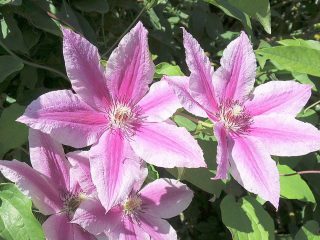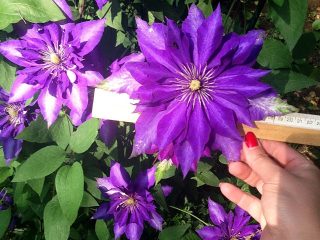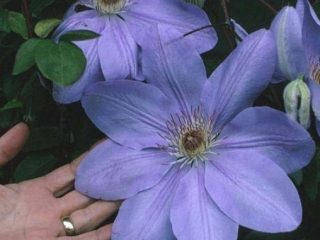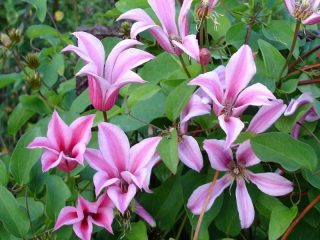Content
Eukomis flower or eukomis (lat. Eucomis) is a small genus of perennial bulbous plants belonging to the Asparagus family. South Africa is considered the birthplace of the culture. The plant is highly decorative, which it retains even after flowering. Growing eucomis flowers does not cause difficulties even for novice gardeners, provided they follow simple care rules. Therefore, it is worth studying the cultural requirements in advance so that problems do not arise later.

Another name for the culture is pineapple lily.
Description of Eucomis with photo
Eucomis flower is a herbaceous bulbous perennial. During the flowering period, its height varies between 30-100 cm. Eucomis leaves are belt-shaped or ovate, depending on the variety. Their length is 25-40 cm and width is about 5-10 cm. They are a rich green color, smooth, shiny with pointed edges. The main vein is clearly visible on the plates. The leaves form a lush basal rosette, 20-25 cm high.
The root system of the flower is represented by an oval fleshy bulb, the diameter of which in adult eucomis reaches 8 cm. During the growing season, the underground part forms a bunch of absorbent roots in the bottom area.
From the center of the leaf rosette of Eucomis, a long, straight, thick stem grows, at the top of which an inflorescence is formed. Its length is 30-40 cm. The inflorescence consists of numerous star-shaped flowers, the diameter of which does not exceed 1 cm. The buds consist of six petals fused at the base. They are light green or cream in color with a lilac or light purple tint.
According to the description, the flowers of the eucomis or pineapple lily grow from short pedicels, the length of which does not exceed 3 cm. In the center of each bud there are six fused stamens with swaying anthers. A bunch of 10-20 green bracts is formed at the top of the inflorescence. This feature makes the plant look like a pineapple, which is why it got its second name.
The ovary of the flower is three-locular, obovate or round. The fruit is a capsule, which, when ripe, opens along three seams. Ripe seeds of the perennial are dark brown or black, round in shape, their size reaches 1 mm.

Eukomis most often forms one peduncle, and only in rare cases two or three
Winter hardiness of Eucomis
This flower belongs to the heat-loving category. For it, the critical temperature is below +3 °C. Therefore, for the winter, eucomis bulbs must be dug up in advance and stored at a temperature of +5 ° C and a humidity of 70-80%.
Types and varieties
In nature, there are about 14 species of pineapple lily. However, only a few of them have found application in gardening, due to their unique decorative qualities. Each type of flower has its own characteristics that are worth paying attention to.
Eukomis autumnale
The peculiarity of this perennial is that it blooms only in August and continues until the end of September. The autumn eucomis flower (Eucomis autumnalis) has a stem height of 30 cm, and the diameter of the leaf rosette is 35-40 cm. The plates are oval-ovate, short. The flowers are white, greenish-light.
This flower is relatively winter-hardy and in the southern regions can winter in open ground with additional insulation.

Autumn Eucomis flowers are collected in brushes
Eukomis bicolor
This type of perennial is also called bicolor. It is especially popular among gardeners. The height of the peduncle of Eucomis bicolor reaches 50-70 cm, and the diameter of the large leaf rosette is 75 cm. The plates are dark green, with burgundy spots on the reverse side.
The inflorescences are club-shaped, and at the top they form a dense bunch of leaves. The shade of the buds of this type of perennial is light green with burgundy edging of the petals. The flowering period begins at the end of June and continues until the second half of August.

In the pineapple two-color lily, the intensity of the edging depends on the light level of the plant
Crested
This type of eucomis prefers to grow in partial shade and moist soils. Forms a peduncle up to 90 long, which confidently rises above the foliage. The plates are green, occasionally speckled, and narrow. Their width is 5 cm and their length reaches 60 cm. The color of flowers in Eucomis comosa is pinkish, white or yellow, depending on the subspecies. But regardless of this, the pestle always has a carmine color.

Eukomis crested propagates well by seeds and bulbs
Mountain
This species does not form a lush rosette of leaves.It consists of only 3-4 plates, on which a pattern consisting of dark and light longitudinal stripes is clearly visible. Mountain Eucomis (Eucomis Montana) forms a peduncle 35-40 cm high. Its leaves are 10 cm wide and 60 cm long. The stem of the plant is slightly speckled. The color of the flowers is cream with a dark center.

Eucomis montana can grow in open and slightly dark places
Royal
This type of perennial is suitable for growing at home because it does not have increased resistance to adverse weather conditions. It also does not tolerate waterlogging of the soil. Royal eucomis (Eucomis regia) feels good on a northern windowsill. Throughout the summer, this type of perennial remains in a dormant stage. The color of its flowers is pinkish-cream with a greenish tint. A lush decorative bunch of leaves is formed at the top of the stem.

Eucomis regal does not like excess light
How to plant eucomis
Eucomis flower planting should be done in the spring, when the earth has warmed up well and the threat of return frosts has passed. The location for the perennial must be chosen taking into account that it reacts poorly to overheating of the bulb. Therefore, the plant should be slightly darkened during the hot afternoon hours.
The eucomis flower prefers loose, nutritious soil that retains moisture, neutral or slightly acidic. The perennial must be planted in an area protected from cold gusts of wind.
The eucomis bulb must be planted to such a depth that its top is level with the surface of the earth. The recommended distance between plants is 30-35 cm.It is necessary to plant with the bottom down, having first poured a layer of sand on the bottom of the hole. At the end of the procedure, the plants must be watered.
Caring for eucomis in open ground
Growing pineapple lilies in open ground is not particularly difficult, even for novice gardeners. It is enough to adhere to standard rules of agricultural technology.
This flower is able to fully develop with sufficient moisture in the soil. Therefore, in the absence of rain for a long time, eucomis must be watered regularly. Moreover, this needs to be done often, but in doses. To water the flower, you can use settled water at a temperature of +20 °C. Moisturizing is carried out near the plant.

After each watering and rain, it is recommended to loosen the soil to ensure air access to the roots of the flower.
To maintain moisture in the soil during particularly hot periods, it is recommended to lay mulch at the base of the perennial. For this you can use humus.
Eucomis flower needs regular feeding, which should be done every two weeks. Complex mineral fertilizers are excellent for the plant. At the beginning of the growing season, it is recommended to use nitroammophoska at the rate of 30 g per 10 liters of water. During the period of peduncle formation and flowering, the perennial must be fed with Kemira Lux in the proportion of 10 g per bucket of water. After flowering, eucomis should be fertilized with potassium monophosphate at the rate of 10 g per 10 liters.This feeding scheme allows the perennial not only to maintain high decorative value throughout the season, but also to accumulate a sufficient amount of nutritional components for the bulb to winter successfully.
After the eucomis peduncle wilts, it should be cut off at the base if there is no need to collect the seeds of the plant. However, it is not recommended to remove the leaves, since they feed the underground part.
At the end of September or at the beginning of October, it is necessary to dig up the bulbs of the eucomis flower. In this case, it is recommended to cut off the leaves, clean the tubers from the soil and dry them for two weeks in a shaded place. After this, they need to be immersed in a solution of the Maxim drug for half an hour, which will prevent the development of pathogenic microflora during storage.

At the end of the procedure, dry the planting material again, but within a few days
Eucomis flower bulbs should be stored in the basement in winter. They can be placed in a wooden box and covered with slightly moistened sand or sawdust.

Eukomis does not bloom when the bulb size is small
Reproduction
This perennial propagates by daughter bulbs, leaf cuttings and seeds. The first two methods make it possible to obtain young plants that fully retain their species properties. And when using the seed propagation method, the grown seedlings can differ significantly from the mother plant and from each other.
During the process of growth, the eucomis flower bulb forms children. They can be separated in the spring and planted in the ground. However, they will begin to bloom only after a few years, when the bulb increases in size and stores up a supply of nutritional components.

The disadvantage of this method of reproduction is that eukomis produces a small number of children.
When using the seed propagation method, you can obtain a sufficient amount of planting material for a given flower. But the growing process takes a long time. It is recommended to plant immediately after collecting Eucomis seeds in the fall. To do this, it is necessary to use wide containers with drainage holes filled with nutritious loose substrate with neutral acidity.
The planting depth of eucomis seeds is 1 cm. After this, the crops must be watered, covered with film or glass and placed in a dark place with a temperature of +23-25 ° C. After the emergence of the eucomis flower, which occurs after 4-6 weeks, the container must be moved to a bright windowsill and the maintenance regime must be reduced to +20 °C. In the future, you must adhere to standard care. When the eucomis flower seedlings grow, they need to be transplanted into separate containers. They can be planted in open ground at the age of two years in the spring. Plants grown from seeds will bloom in the fifth year.
The fastest way to propagate your favorite variety of Eucomis flower is by leaf cuttings. To do this, it is necessary to cut off the plate at the base during the active growing season of the plant and divide it into parts 4-6 cm long. The lower part of the cuttings must be buried 2 cm in a loose soil mixture consisting of peat and sand in equal quantities, watered with Kornevin’s solution, and transferred to the container on a light windowsill and make a mini-greenhouse on top.
Every day, eucomis flower seedlings need to be ventilated for half an hour, and watered as the top layer of soil dries. After 2.5-3 months, daughter bulbs form on the edge of the cuttings. They must be carefully separated and planted in containers.It is recommended to plant young eucomis flower plants in open ground next year in early June, when the ground has warmed up well.

With regular waterlogging, leaf cuttings of eucomis quickly rot
Pests and diseases
This perennial is susceptible to spider mites, aphids, mealybugs, and whiteflies. The likelihood of pests increases with a lack of nutrition, as well as during hot weather. In this case, the growth of the eucomys slows down, the peduncle is deformed, the buds fall off without opening, and the leaves lose their glossy shine. To kill pests, it is recommended to spray the perennial with Actellik or Fufanon.

If necessary, repeat treatment after a week
The eucomis flower also suffers from rotting bulbs. In this case, a sharp yellowing of the leaves and wilting of the peduncle occurs. Treatment in this case is useless. Preventative treatment of tubers before storage and planting in open ground allows you to prevent damage. For this, it is recommended to use the drugs Maxim and Previkur Energy.
Eucomis in landscape design
This plant looks original throughout the season. At the beginning of summer, its large leaf rosette attracts the eye, and from June until the end of September, the perennial delights with its flowering. Therefore, eucomis has gained popularity as an effective element of landscape design.

The plant looks good in single plantings, as well as in combination with other crops.
Best partners:
- low-growing conifers;
- heuchera;
- alyssum;
- lobelia;
- gerbera;
- petunia.
The eucomis flower also looks impressive against the background of a green lawn.It can be used in mixborders, on rocky hills, as well as in flower beds.

The perennial has an accelerated growth rate
Conclusion
The eucomis flower will not go unnoticed even in a large collection of garden plants. After all, its unusual appearance and long flowering can leave few people indifferent. Therefore, more and more gardeners are growing it in their garden plots, despite the fact that the perennial needs a warm winter.
Reviews on growing Eucomis
